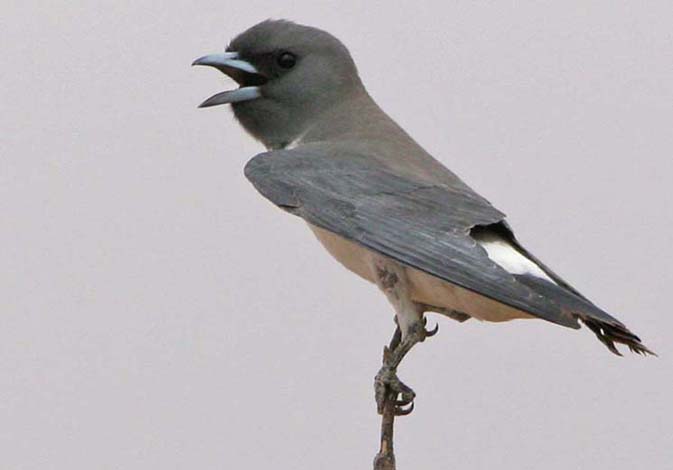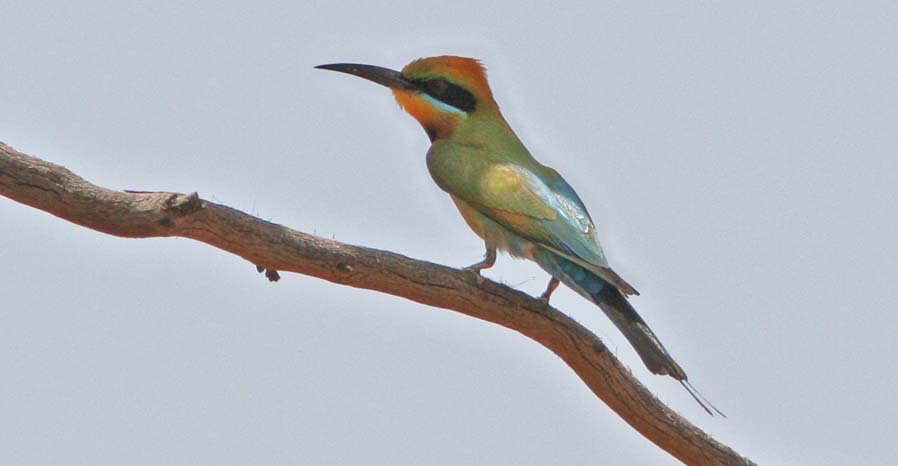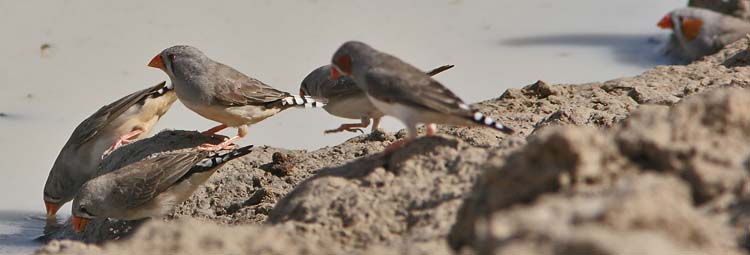 South Australia
South Australia
18-22 Nov 2009
This is my personal list of birds seen during the South Australia tour in Nov 2009. Those proceeded by asterisk (*) were lifers for me. An “I” preceding a species name is a non-native introduced species in Australia.
Other trip reports from this tour are on the web: Peter Waanders [daily journal; includes ~40 species I didn't see, presumably many of which were heard only) and Bruce Wedderburn [site lists for our visits]. Birds seen by others, and that I heard about during the trip, are at the end.
My total was 129 native birds, plus 4 introduced species; 29 birds were new lifers for me.
White-breasted Woodswallow
(right, Birdsville Track)
Emu Dromaius novaehollandiae:
seen widely in wooded habitat, including Gluepot & Flinders Ranges;
up to 30/day at latter locale, with many males with precocial young
Plumed Whistling-Duck Dendrocygna eytoni: one on stock pond well north on Birdsville Track (below, with Australian Black Duck)

Maned Duck Chenonetta jubata: singles by me at Pandiburra Bore & Port Gawler; others had more
Pink-eared Duck Malacorhynchus membranaceus: scattered at small marshes or ponds along Birdsville Track (above, left)
Chestnut Teal Anas castanea: one with precocial young seen on pond near Port Gawler
Gray Teal Anas gracilis: good numbers (75) at Pandiburra Bore; more at Mungerannie marsh
Pacific Black Duck Anas superciliosa: a few pairs on ponds along Birdsville Track; 30+ on pond at Port Gawler
* Stubble Quail Coturnix pectoralis: single, probably female, seen in flight when flushed off Birdsville Track
Australian Grebe Tachybaptus novaehollandiae: a couple on a pond on Birdsville Track; another at P. Gawler
Australian Ibis Threskiornis molucca: I saw one in flight at Port Gawler; others had some in the Flinders
Glossy Ibis Plegadis falcinellus: Flock of 20+ at Pandiburra Bore; a few others at Birdsville Track wet spots
Great Egret Ardea alba: one near Norman; some split this as “Eastern Great Egret A. modesta”
White-necked Heron Ardea pacifica: one flushed from Pandiburra Bore marsh
White-faced Heron Egretta novaehollandiae: scattered birds along coast at Port Gawler & Adelaide
Little Egret Egretta garzetta: a few at Port Gawler
Rufous Night-Heron Nycticorax caledonica: single imms at marshes ~95 km N of Marree & at Mungerannie
Australian Pelican Pelecanus conspicillatus: a dozen flushed from a stock pond along Birdsville Track; many more in Adelaide vicinity
Great Cormorant Phalacrocorax carbo: many in Adelaide vicinity
Pied Cormorant Phalacrocorax varius: one flushed at Port Gawler
* Letter-winged Kite Elanus scriptus: two pairs nesting near upper Birdsville Track were a major trip highlight
Whistling Kite Haliastur sphenurus: a few recorded most days, and more seen in the Flinders Range than elsewhere; nest found 75 km N of Marree
Black Kite Milvus migrans: fairly common and seen most days; 30+ along upper Birdsville Track
Collared Sparrowhawk Accipiter cirrocephalus: an adult was watched drinking from Brachina Creek in Flinders Range, and scattered birds every time it flew by; an Accipiter sp? was in flight south of Leigh Creek
Spotted Harrier Circus assimilis: 8+ encountered over grasslands well up the Birdsville Track
Wedge-tailed Eagle Aquila audax: a few seen every day, usually from the vehicle in route somewhere
Nankeen Kestrel Falco cenchroides: a few seen daily, usually while enroute
Brown Falcon Falco berigora: widespread in small numbers, but 15+ along upper Birdsville Track
Black Falcon Falco subniger: pair well north along Birdsville Track; singles ~95 km N of Marree & another N of Port Gawler
Australian Bustard Choriotis australis: three flushed from grassland well up the Birdsville Track (one below)

Purple Swamphen Porphyrio porphyrio: conspicuous in isolated wetlands up the Birdsville Track
Black-tailed Native-hen Tribonyx ventralis: common is wetlands along Birdsville Track; also along coast
Eurasian Coot Fulica atra: one in Mungerannie marsh
Brolga Grus rubicunda: two near small wetland ~75 km N of Marree
Black-winged Stilt Himantopus himantopus: a few in wetlands along Birdsville Track
* Banded Stilt Cladorhynchus leucocephalus: five in coastal salt marsh at Port Augusta
Red-necked Avocet Recurvirostra novaehollandiae: flock of 40+ at Port Augusta; others saw a few elsewhere
Black-fronted Dotterel Elseyornis melanops: a few daily at wet spots along the Birdsville Track
* Oriental Plover Chadarius veredus: four in basic plumage at Pandiburra Bore marsh were rarities here
Red-kneed Dotterel Erythrogonys cinctus: a few (3-8/day) at wetlands along the Birdsville Track
Masked Lapwing Vanellus miles: two each ~95 km N of Marree; at Mungerannie; and at Port Gawler
* Inland Dotterel Peltohyas australis: amazing numbers for this elusive dry-country plover: two on lawn at Lyndhurst Pub, another well up Birdsville Track; and a flock of at least 25 on gibber plain near Mulka ruins
Common Greenshank Tringa nebularia: one calling at Port Gawler
Sharp-tailed Sandpiper Calidris acuminata: three at Pandiburra Bore marsh; another at Mungerannie
Ruff Philomachus pugnax: a male in basic plumage in Pandiburra Bore marsh
* Australian Pratincole Stiltia isabella: at least 40 scattered at various wetlands well up Birdsville Track
Caspian Tern Hydroprogne caspia: one at Port Gawler
Silver Gull Chroicocephalus novaehollandiae: common along the coast and up the Murray River at Waikerie & Norman
I Rock Pigeon Columba livia: introduced in larger cities and coastal towns
I Spotted Dove Streptopelia chinensis: introduced species common in Adelaide suburbs
Common Bronzewing Phaps chalcoptera: a couple seen enroute to Gluepot
* Flock Bronzewing Phaps histrionic: huge flocks darkening the skies along upper Birdsville Track; estimated 8000+ over a short one-mile stretch, but they were encountered only there
Crested Pigeon Ocyphaps lophotes: widespread and common in many areas away from the mallee
Peaceful Dove Geopelia striata: singles at a couple stops on Birdsville Track; more in Adelaide
* Diamond Dove Geopelia cuneata: one at Mungerannie marsh and a dozen in small woods 75 km N of Marree
Galah Eolophus roseicapillus: common in flocks in countryside of southern South Australia but very local in the north, with a few at Lyndhurst and a couple near Leigh Creek
Little Corella Cacatua sanguina: common and widespread, often in huge flocks on the ground, but more local and limited up the Birdsville Track
Rainbow Lorikeet Trichoglossus haematodus: a few seen from car in Adelaide
Musk Lorikeet Glossopsitta concinna: a couple seen in Adelaide
Ringneck Parrot Barnardius zonarius: two subspecies were encountered; small flocks of Mallee Ringneck B. z. barnardi were enroute to and in Gluepot Reserve, and a few Pt Lincoln Ringneck B. z. zonarius were in the Flinders Range
Regent Parrot Polytelis anthopeplus: a few seen near Norman on Murray River; a couple more near Leigh Creek
Blue Bonnet Northiella haematogaster: small parties of 3-5 birds of the yellow-vented nominate race were seen along lower Birdsville Track (e.g., 53 km N of Marree)
Red-rumped Parrot Psephotus haematonotus: a couple in the Flinders and small flock near Port Augusta
Mulga Parrot Psephotus varius: pairs seen at Gluepot Reserve and at Arid Lands Botanical Garden
Elegant Parrot Neophema elegans: a pair at Brachina Creek in Flinders Range
* Budgerigar Melopsittacus undulatus: one in flight up the Birdsville Track; four more is small wood 75 km N of Marree
Sacred Kingfisher Halcyon sancta: one watched calling at Mungerannie marsh
* Red-backed Kingfisher Todiramphus pyrrhopygius: calling bird tracked down at dawn at Gluepot Reserve; Peter heard more elsewhere
Rainbow Bee-eater Merops ornatus: fairly common at small woods up the Birdsville Track; also at Gluepot (below)

Superb Fairy-wren Malurus cyaneus: a party of fairywrens at Port Gawler were this species, per Peter and range
White-winged Fairy-wren Malurus leucopterus: fairly common in arid desert habitat up the Birdsville Track
Variegated Fairy-wren Malurus lamberti: male bathed in Brachina Creek, Flinders Range; more were present locally in more vegetated sites up the Birdsville Track
* Striated Grasswren Amytornis striatus: a single bird found after found effort at Gluepot Reserve
* Short-tailed Grasswren Amytornis merrotsyi: pair watched at Stokes Hill in Flinders Range; one disappeared down a burrow when we got too close
* Thick-billed Grasswren Amytornis textilis modestus: a pair and a lone bird observed nicely in saltbrush scrub near Lyndhurst
* Eyrean Grasswren Amytornis goyderi:
several pairs encountered on stable sand dunes up the Birdsville Track,
where they were very elusive but, in time, good views obtained
* Gray Grasswren Amytornis barbatus: at least two pairs plus a fledgling in dry lingnum swamp habitat well up the Birdsville Track
* Pied Honeyeater Certhionyx variegatus:
at least 6 males watched fly-catching in dry lingnum swamp well up the
Birdsville Track; a female photographed at a water hole nearby; and
pairs with young seen at Arid Lands Botanical Gardens near Port Augusta
Singing Honeyeater Lichenostomus virescens: common in botanical garden near Port Augusta; a few elsewhere
Yellow-plumed Honeyeater Lichenostomus ornatus: common in mallee at Gluepot
White-plumed Honeyeater Lichenostomus penicillatus: fairly common in flowering scrub at local spots on Birdsville Track
White-fronted Honeyeater Purnella albifrons: singles seen at Gluepot and in Flinders Range
Noisy Miner Manorina melanocephala: common in Adelaide
Yellow-throated Miner Manorina flavigula: flock of 10+ near Gluepot; one at Mungerannie
* Black-eared Miner Manorina melanotis:
one with flock of Yellow-throats near Gluepot showed much dark in
malar, a rump uniform with back, and darker overall cast, fitting the
characters of this endangered taxon. Another bird in the same flock,
with intermediate rump pattern, was likely an intergrade
Spiny-cheeked Honeyeater Acanthagenys rufogularis: a few (2-4/day) at Gluepot & Flinders Range; several in botanical garden near Port Augusta
* Crimson Chat Epthianura tricolor: fairly common, but quite flighty, in Gluepot mallee and local spots up the Birdsville Track
* Orange Chat Epthianura aurifrons:
a male & half-dozen females in fields near Waikerie, but over 50
scattered widely during one day well up the Birdsville Track
* Yellow Chat Epthianura crocea:
one male watched with scope for extended period at Pandiburra Bore; it
foraged at marsh edge (others thought there might be two birds here)
* Gibber Chat Ashbyia lovensis:
pair found walking through tiny blades of grass in the otherwise bleak
gibber plain near Mulka ruins, south of Mungerannie on Birdsville Track
New Holland Honeyeater Phylidonyris novaehollandiae: one seen from vehicle in Adelaide
[ Red-browed Pardalote Pardalotus rubricatus:
one singing repeatedly in small woods 75 km N of Marree, but did not
approach despite much use of tape. Would have been a lifer had I seen
it. ]
White-browed Scrubwren Sericornis frontalus: one of the rosina race seen nicely in salt scrub at Port Gawler
* Slender-billed Thornbill Acanthiza iredalei: several of the rosinae race were nicely viewed in samphire scrub at Port Gawler
Southern Whiteface Aphelocephala leucopsis: about a dozen in open country near Waikerie
* Banded Whiteface Aphelocephala nigricincta: four, including a nice male, on dune outside Mungerannie
White-browed Babbler Pomatostomus superciliosus: scattered birds: Waikerie, Flinders Range, Port Augusta
Chestnut-crowned Babbler Pomatostomus ruficeps: a party of 20 or so in mallee edge near Waikerie
* Chirruping Wedgebill Psophodes cristatus: a half-dozen or more calling in flooded road-edge south of Leigh Creek; several more in botanical garden near Port Augusta
* Cinnamon Quail-thrush Cinclosoma cinnamomeum: nice views of a female near Lyndhurst, a couple pairs up the Birdsville Track, and another south of Mungerannie
* Chestnut Quail-thrush Cinclosoma castanotum: male called up at dawn at Gluepot; I missed the female of this pair, seen by others
Crested Bellbird Oreoica gutturalis:
this distinctive bird, now proposed to be part of a new family
[Oreoicadae], was at Gluepot, where two were seen and others heard
White-breasted Woodswallow Artamus leucorhynchus: fairly common up the Birdsville Track, in mixed flocks with other woodswallows (photo at top of page)
* Masked Woodswallow Artamus personatus: good numbers (sometimes 40-50/day), often with other woodswallows, at Gluepot and widely scattered in north South Australia
White-browed Woodswallow Artamus superciliosus: just a couple seen in mixed flocks at Gluepot
Black-faced Woodswallow Artamus cinereus:
a fairly common dark woodswallow, often in mixed flocks, up the
Birdsville Track; a few more dark woodswallows seen poorly near Gluepot
may have been this species
Australian Magpie Cracticus tibicen: common roadside bird in southern South Australia; more local to the north
Black-faced Cuckoo-shrike Coracina novaehollandiae: a couple birds seen from vehicle enroute in south South Australia
White-winged Triller Lalage sueurii: a couple at Gluepot; a few present at most patches of wooded scrub near wetlands along the Birdsville Track
[ Gilbert's Whistler Pachycephala inornata: one heard at Gluepot but refused to come to tape. ]
* Red-lored Whistler Pachycephala rufogularis: excellent and prolonged views of a pair outside Gluepot, highlighted by a singing male, that were roused to action by the tape
Gray Shrike-thrush Colluricincla harmonica: heard commonly in Gluepot; others had it elsewhere also
Willie Wagtail Rhipidura leucophrys: a few birds, mostly heard, in wooded areas: Gluepot, Flinders Range, Mungerannie marsh
Magpie-lark Grallina cyanoleuca: a roadside bird throughout, seemingly more common in the south
Australian Raven Corvus coronoides: reasonably common throughout (10-20/daily)
Little Raven Corvus mellori: a couple near Waikerie were in its limited range to the south
Little Crow Corvus bennetti: up to 10/day in scrub around Leigh Creek and vicinity
White-winged Chough Corcorax melanorhamphos: small parties (5-7/day) at Gluepot and in Flinders Range
Red-capped Robin Petroica goodenovii: common in mallee at Gluepot
Australian Bushlark Mirafra javanica: one drinking at stock pond up Birdsville Track
Southern Scrub-robin Drymodes brunneopygia: two seen, two more heard, in mallee at Gluepot Reserve
White-backed Swallow Cheramoeca leucosterna: one over marsh at Mungerannie; a few more at botanical gardens near Port Augusta
Welcome Swallow Hirundo neoxena: widespread on trip from Flinders Range on
Fairy Martin Petrochelidon ariel: a handful among swallow flock at botanical gardens near P. Augusta
Tree Martin Petrochelidon nigricans: widespread on trip from Flinders Range on
Little Grassbird Megalurus gramineus: one seen nicely at Mungerannie marsh
Australian Reed-Warbler Acrocephalus australis: a few (1-3/stop) in reeds at wetlands along Birdsville Track
Brown Songlark Cincloramphus cruralis: a few scattered along roadsides in Flinders to Lyndhurst
* Rufous Songlark Cincloramphus mathewsi: one at roadside near Brachina Creek in Flinders Range
I Common Starling Sturnus vulgaris: this non-native was common from Port Augusta to Adelaide
Zebra Finch Taeniopygia guttata: large flocks (up to 200/day) up the Birdsville Track (below)
Australasian Pipit Anthus novaeseelandiae: common in grasslands and plains up the Birdsville Track
I House Sparrow Passer domesticus: a non-native common in cities; a few up at Mungerannie pub

SEEN or HEARD BY OTHERS ON TRIP: I heard talk about the presence of Black-shouldered Kite Elanus axillaris, Red-capped Dotterel Charadrius ruficapillus, Crimson (Yellow) Rosella Platycercus elegans flaveolus, Black-eared Cuckoo Chrysococcyx osculans, White-fronted Chat Epthianura albifrons, Weebill Smicrornis brevirostris, Chestnut-rumped Thornbill Acanthiza uropygialis, Gray Butcherbird Cracticus torquatus, Pied Butcherbird Cracticus nigrogularis, Varied Sittella Daphoenositta chrysoptera (heard but not seen), and Common Blackbird Turdus merula (introduced species). Additional birds are listed on trip reports published by others, but I did not hear about them during the trip.
EFFORT BUT MISSED: We made special efforts for Gray Falcon Falco hypoleucos [known perch a few weeks prior], Black Honeyeater Certhionyx niger, Rufous Fieldwren Calamanthus campestris [one seen in flight near Lyndhurst was likely this bird, attracted to tape, but untickable views], and Redthroat Pyrrholaemus brunneus, but did not succeed in those efforts.
EFFORT WASHED OUT: Plans to look for Chestnut-breasted Whiteface Aphelocephala pectoralis near Lyndhurst on 22 Nov were washed out by the torrential rains.
South Australia MALLEE, FLINDERS & COASTAL HIGHLIGHTS |
|
South Australia BIRDSVILLE TRACK HIGHLIGHTS |
|
page created 2 Dec 2009
|
© Don Roberson 2009 |